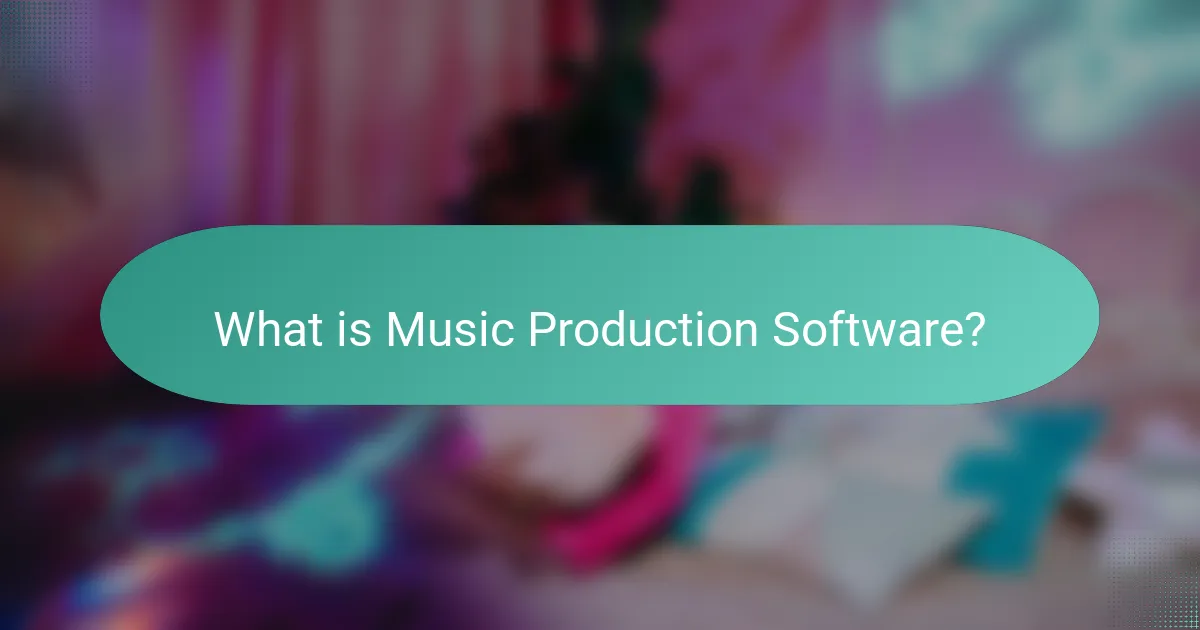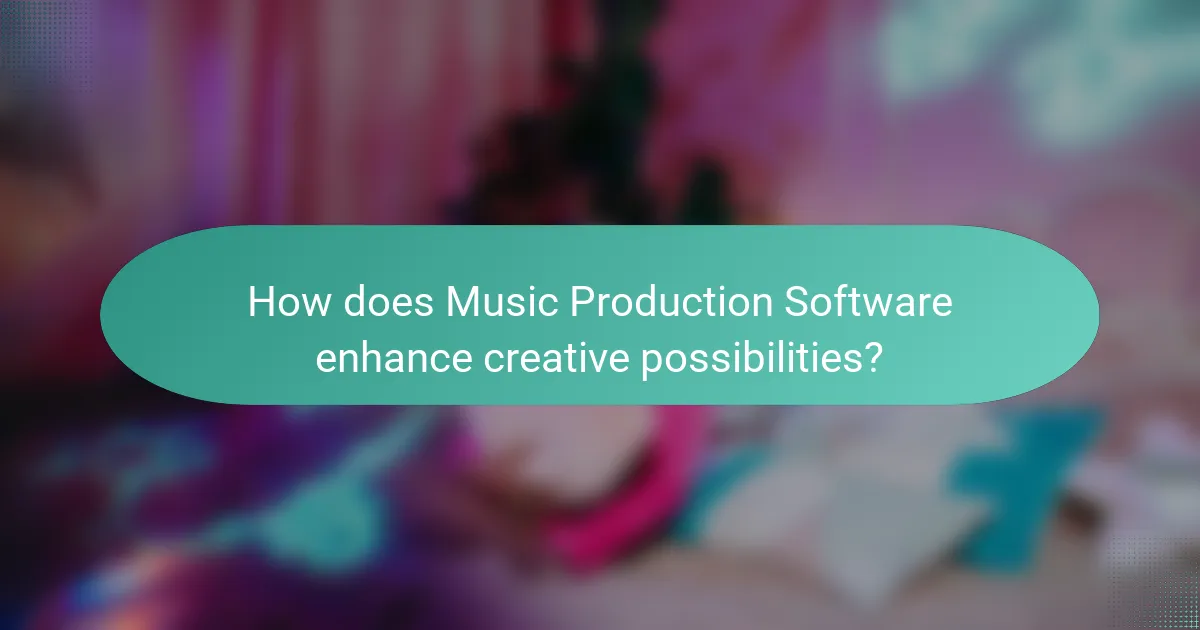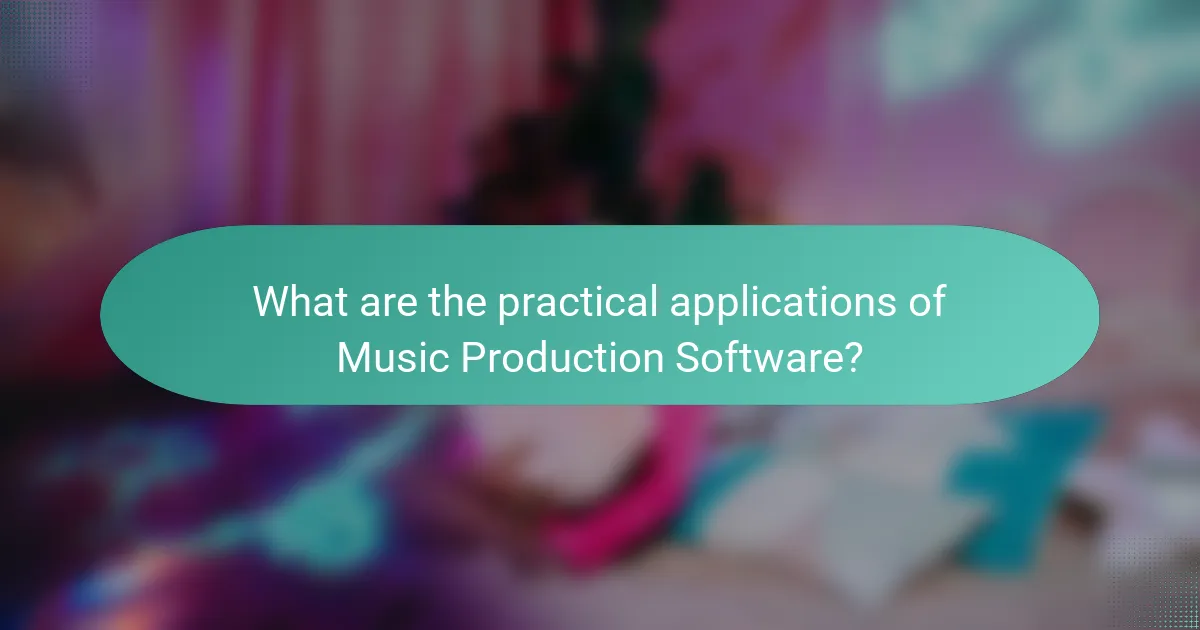Music production software, commonly known as Digital Audio Workstations (DAWs), are digital tools essential for creating, editing, and producing audio. This article explores the features and user interfaces of various music production software, highlighting their role in enhancing creative possibilities for musicians. It discusses the functionalities such as multi-track recording, virtual instruments, and effects plugins that allow for diverse sound creation and efficient music composition. The article also examines the practical applications of DAWs in the music industry, including their significance in remote collaboration and their growing market value, which was approximately $1.1 billion in 2021. Overall, it emphasizes how music production software democratizes music creation, making it accessible to a wider audience.

What is Music Production Software?
Music production software is a digital tool used for creating, editing, and producing audio. It allows users to record live instruments, arrange musical compositions, and mix tracks. Commonly referred to as Digital Audio Workstations (DAWs), these programs provide various features for sound manipulation. Popular examples include Ableton Live, Logic Pro, and FL Studio. Music production software often includes virtual instruments and effects plugins. It enables musicians to collaborate remotely and share projects easily. In 2021, the global DAW market was valued at approximately $1.1 billion, reflecting its growing importance in music creation.
How has Music Production Software evolved over the years?
Music production software has evolved significantly over the years. Initially, in the 1980s, music production relied on hardware synthesizers and tape machines. The introduction of MIDI in the early 1980s allowed for digital communication between devices, enhancing production capabilities. In the 1990s, software like Pro Tools emerged, enabling multi-track recording on computers. This shift allowed for greater flexibility and editing options compared to traditional methods.
By the 2000s, Digital Audio Workstations (DAWs) became mainstream. Software such as Ableton Live and Logic Pro introduced user-friendly interfaces and advanced features. These tools allowed users to manipulate audio with precision and creativity. The rise of VST plugins expanded sound design possibilities, enabling users to access a vast library of virtual instruments and effects.
In recent years, cloud-based platforms and mobile applications have further transformed music production. Users can now collaborate remotely and access their projects from various devices. The integration of artificial intelligence has also begun to influence music production, offering automated mixing and mastering solutions. Overall, music production software has transitioned from hardware-based systems to versatile, software-driven environments that empower creators.
What were the early forms of Music Production Software?
Early forms of music production software included sequencers and digital audio workstations (DAWs). Sequencers like MIDI sequencers allowed musicians to record and edit music digitally. Notable early examples include Cakewalk and Cubase, which emerged in the 1980s. These programs enabled users to manipulate MIDI data for composing and arranging music. Digital audio workstations like Pro Tools were developed in the late 1980s for recording and editing audio. They provided a platform for mixing and producing music with greater precision. These early software innovations laid the groundwork for modern music production tools.
What technological advancements have influenced Music Production Software?
Technological advancements such as digital audio workstations (DAWs), virtual instruments, and cloud computing have significantly influenced music production software. DAWs replaced traditional recording methods, allowing for multi-track recording and editing. Virtual instruments provided musicians with software-based alternatives to physical instruments, enhancing sound variety. Cloud computing enabled collaborative music production across distances, facilitating real-time sharing and editing. Additionally, advancements in MIDI technology improved the integration of hardware and software, streamlining the production process. These innovations have collectively transformed how music is created, recorded, and produced.
What are the key features of modern Music Production Software?
Modern music production software features advanced audio editing capabilities. These capabilities include multi-track recording and non-destructive editing. Users can manipulate audio clips easily, allowing for precise adjustments. Many programs offer built-in virtual instruments and effects. These tools enhance creativity and sound design. Additionally, modern software supports MIDI recording and editing. This feature allows for seamless integration with hardware instruments. Collaboration tools also facilitate sharing projects with other musicians. These features collectively improve workflow and enhance the overall production experience.
How do different software platforms compare in terms of features?
Different software platforms for music production vary significantly in features. For instance, Ableton Live excels in real-time performance and loop-based composition. Logic Pro offers extensive MIDI capabilities and a vast library of sounds. Pro Tools is renowned for its advanced audio editing and mixing features. FL Studio is popular for its intuitive interface and strong beat-making tools. Each platform caters to different user needs, from beginners to professionals. The diversity in features allows users to choose software that aligns with their specific production goals and workflows.
What role do plugins and virtual instruments play in Music Production Software?
Plugins and virtual instruments enhance music production software by providing additional sounds and effects. They allow producers to create diverse audio landscapes. Plugins can include synthesizers, samplers, and audio effects. Virtual instruments replicate real instruments digitally, offering versatility in sound creation. These tools expand the creative possibilities within the software. According to a 2020 survey by Sound on Sound, over 70% of music producers use plugins regularly. This demonstrates their integral role in modern music production workflows.
What are the user interface design principles in Music Production Software?
User interface design principles in music production software include clarity, consistency, feedback, and accessibility. Clarity ensures that visual elements are easy to understand. Consistency maintains uniformity in design across different sections. Feedback provides users with information on their actions, such as visual or auditory cues. Accessibility ensures that the software can be used by individuals with varying abilities. These principles enhance usability and improve the overall user experience. Effective implementation of these principles is supported by user-centered design methodologies.
How does user interface design affect workflow in Music Production Software?
User interface design significantly affects workflow in music production software. A well-designed interface enhances user efficiency and productivity. Intuitive layouts allow for quicker access to essential tools. This reduces time spent navigating menus and increases focus on creativity. Visual clarity helps users understand complex features easily. Consistent design elements create a familiar environment, minimizing the learning curve. Research shows that user satisfaction directly correlates with effective interface design. A study by Nielsen Norman Group highlights that usability improvements can lead to a 50% increase in task completion rates. Thus, user interface design plays a crucial role in optimizing workflow in music production software.
What are common user interface elements found in Music Production Software?
Common user interface elements found in music production software include the mixer, timeline, and track view. The mixer allows users to control audio levels and effects for each track. The timeline displays the arrangement of audio clips and MIDI data. The track view shows individual tracks for editing and arrangement.
Other elements include transport controls for playback and recording. Additionally, there are virtual instruments and effects plugins accessible within the interface. Menus and toolbars provide access to various functions and settings. These elements enhance the user experience and facilitate music creation.

How does Music Production Software enhance creative possibilities?
Music production software enhances creative possibilities by providing a wide range of tools and features for musicians. It allows users to compose, edit, and mix music efficiently. Features like virtual instruments and MIDI capabilities enable diverse sound creation. Users can experiment with various effects and plugins to shape their sound uniquely. The software supports multi-track recording, allowing for complex arrangements. Additionally, it offers intuitive user interfaces that streamline the creative process. Many programs include built-in tutorials and resources to inspire creativity. Overall, music production software democratizes music creation, making it accessible to a broader audience.
What creative tools are available in Music Production Software?
Music production software offers a variety of creative tools. These tools include digital audio workstations (DAWs), virtual instruments, and audio effects. DAWs allow users to record, edit, and arrange music. Popular DAWs include Ableton Live, FL Studio, and Logic Pro. Virtual instruments provide sounds like synthesizers, drum machines, and samplers. Audio effects such as reverb, delay, and equalization enhance sound quality. MIDI capabilities enable users to compose and manipulate music digitally. Collaboration features allow multiple users to work on projects simultaneously. These tools collectively empower musicians to create diverse and innovative music.
How do MIDI and audio editing tools foster creativity?
MIDI and audio editing tools foster creativity by providing musicians with versatile options for sound manipulation. These tools allow users to compose, arrange, and edit music in innovative ways. MIDI tools enable precise note control and sequencing, facilitating unique musical ideas. Audio editing software offers features like looping, effects, and pitch correction, enhancing sound design possibilities. The combination of these functionalities encourages experimentation and exploration. Research shows that accessibility to such tools increases creative output among musicians. A study by the Berklee College of Music found that digital tools significantly enhance the creative process for composers.
What role do effects and sound manipulation play in music creation?
Effects and sound manipulation are crucial in music creation. They enhance the sonic quality and emotional impact of a piece. Effects such as reverb, delay, and distortion shape the overall sound. Sound manipulation techniques include sampling, pitch shifting, and modulation. These processes allow artists to create unique textures and atmospheres. Studies show that sound effects can significantly influence listener perception and engagement. For instance, a 2019 study by the Journal of Music Technology found that specific effects can evoke particular emotions in listeners. Overall, effects and sound manipulation expand creative possibilities in music production.
How can collaboration be facilitated through Music Production Software?
Collaboration can be facilitated through music production software by providing shared workspaces and cloud storage. These features allow multiple users to access projects simultaneously. Real-time editing enables instant feedback and adjustments. Integrated communication tools help streamline discussions among collaborators. Version control systems maintain project integrity by tracking changes. Many platforms support various file formats, ensuring compatibility. Collaboration tools like MIDI sharing enhance creative input from different musicians. These functionalities collectively improve the collaborative experience in music production.
What features promote collaboration among musicians using Music Production Software?
Real-time collaboration tools promote effective teamwork among musicians using Music Production Software. These tools allow multiple users to work on the same project simultaneously. Features such as cloud storage enable easy access to shared files. Integrated chat functions facilitate instant communication between collaborators. Version control systems help track changes and maintain project integrity. Audio and MIDI sharing options allow seamless exchange of musical ideas. Collaborative editing features streamline the process of making adjustments together. These functionalities enhance the overall creative process and improve workflow efficiency.
How do cloud-based solutions impact collaborative music production?
Cloud-based solutions significantly enhance collaborative music production. They allow multiple users to work on the same project simultaneously from different locations. This accessibility fosters real-time collaboration, enabling instant feedback and adjustments. Cloud storage facilitates easy sharing of large audio files without the need for physical media. Furthermore, these solutions often integrate various tools and plugins, streamlining the production process. A study by the Journal of New Music Research found that cloud collaboration increases productivity by 30% among musicians. This evidence supports the notion that cloud-based platforms are transforming how music is produced collaboratively.

What are the practical applications of Music Production Software?
Music production software has several practical applications in the music industry. It allows users to create, edit, and arrange music digitally. Musicians can record audio and MIDI tracks using various virtual instruments. The software also enables mixing and mastering to enhance sound quality. Additionally, it supports collaboration between artists and producers remotely. Music production software is used for film scoring, video game soundtracks, and podcast production. According to a 2021 survey by Sound on Sound, 75% of music producers rely on digital audio workstations for their projects. This highlights the software’s central role in modern music creation and production processes.
How is Music Production Software used in different genres of music?
Music production software is utilized across various genres to enhance creativity and streamline production processes. In electronic music, software enables artists to create complex soundscapes using synthesizers and digital audio workstations (DAWs). Hip-hop producers often use sampling features to incorporate diverse sounds and beats, facilitating innovative compositions. Rock musicians leverage software for recording live instruments and layering tracks, allowing for intricate arrangements. Pop music production frequently employs MIDI sequencing to manipulate melodies and rhythms effectively. In classical music, software aids in orchestration and arrangement, providing tools for virtual instruments. Each genre benefits from specific features tailored to its unique sound and production requirements. The versatility of music production software supports a wide range of artistic expressions and technical needs.
What specific features are beneficial for electronic music production?
Digital audio workstations (DAWs) are essential for electronic music production. They provide multi-track recording capabilities for layering sounds. MIDI support allows for precise control over virtual instruments. Built-in synthesizers and effects enhance sound design possibilities. Automation features enable dynamic changes over time in tracks. Looping capabilities facilitate repetitive patterns and arrangements. Audio editing tools ensure precise manipulation of sound samples. The availability of plugins expands creative options significantly. These features collectively enhance the workflow and creativity in electronic music production.
How does Music Production Software cater to film and game scoring?
Music production software caters to film and game scoring by providing specialized tools and features tailored for these industries. It offers a range of virtual instruments and sound libraries that mimic orchestral and cinematic sounds. These libraries include pre-recorded samples that can be easily integrated into projects. Additionally, the software supports MIDI sequencing, allowing composers to create intricate musical arrangements.
Many programs also feature audio editing capabilities, enabling precise manipulation of soundtracks. Collaboration tools within the software facilitate teamwork among composers, sound designers, and directors. Furthermore, some platforms allow for real-time scoring, making it easier to sync music with visual elements. The flexibility of these software solutions supports various genres and styles, accommodating diverse creative needs in film and game production.
What tips can enhance the user experience with Music Production Software?
To enhance the user experience with music production software, users should familiarize themselves with the software’s features. Understanding the layout and tools can significantly improve workflow efficiency. Regularly updating the software ensures access to the latest features and bug fixes. Utilizing keyboard shortcuts can speed up the production process and reduce reliance on mouse clicks. Organizing projects and files systematically aids in quick access and reduces frustration. Engaging with online tutorials and community forums can provide valuable insights and tips. Customizing the interface to suit personal preferences improves comfort and usability. Finally, experimenting with different plugins and sound libraries expands creative possibilities and enhances the overall experience.
How can beginners effectively learn to use Music Production Software?
Beginners can effectively learn to use music production software by following structured tutorials and practicing regularly. Online platforms offer numerous resources, including video tutorials and step-by-step guides. Engaging with community forums can provide support and additional insights. Experimenting with different features in the software fosters hands-on experience. Setting specific goals for each practice session enhances learning outcomes. Utilizing templates and presets can simplify the initial learning curve. Additionally, understanding the software’s interface through exploration aids in navigation. Consistent practice leads to improved skills over time.
What troubleshooting tips are commonly needed for Music Production Software users?
Common troubleshooting tips for Music Production Software users include checking system requirements. Ensure the software is compatible with the operating system. Users should also update their software regularly to fix bugs. Restarting the software can resolve minor glitches. Checking audio settings helps in resolving sound issues. Users should also verify plugin compatibility with the software. Clearing cache and temporary files can improve performance. Lastly, consulting the user manual or online forums can provide specific solutions.
Music production software, commonly known as Digital Audio Workstations (DAWs), is a digital tool essential for creating, editing, and producing audio. This article explores the evolution of music production software, highlighting advancements such as MIDI integration, virtual instruments, and cloud-based collaboration tools. Key features of modern DAWs, including audio editing capabilities, user interface design principles, and the role of plugins, are examined to illustrate how they enhance creative possibilities. Additionally, the practical applications of music production software across various genres, including film scoring and electronic music, are discussed, along with tips for beginners and troubleshooting advice for users.